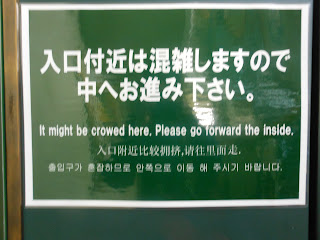I’m sure many people, both Japanese and foreign, absolutely love Japanese fashion. They feel like it fits perfectly into their little vision of the world. Unfortunately, I am neither of those people. Japanese fashion never fails to confuse and perplex me, both out in the real world and while I’m at work.
Let’s start with work. I work at a Senior High School, where the dress code is professional. No t-shirts, no jeans. You all know what professional is. Imagine my surprise when I showed up on my first day in a pencil skirt, a white button-down blouse, and a pair of heels, and only about half the office was wearing anything remotely businessy. What was the other half wearing, you may ask? I’m glad you did.
 |
| I have no photos of me looking businessy, but here's one sort of! |
They were wearing track suits. Track suits with perfectly matching tops and bottoms, manufactured by adidas, nike, or any other sports brand you could think of. In fact, I’m pretty sure that Japanese schoolteachers are single-handedly keeping these companies in business. Forget running shoes and fancy pacemakers, track suits are their market. I didn’t let this get to me, though. I just assumed that all these teachers wearing track suits must have been PE teachers. Imagine my surprise, 8 months later, when I am invited to my first enkai and I finally get around to asking what subjects the teachers teach.

“My neighbour teaches PE, right?” I asked my supervisor, looking over at his track-suit.
“Right.” she replied, following my gaze.
“And my other neighbour?” My glance skipping over to another tracksuit-clad teacher.
“He teaches history.” she replied.
“Not PE?” I asked, surprised.
“Nope.”
“What about her? And him? And him?” I asked, picking out teachers at random.
“Japanese. Science. Also History.”
“None of them teach PE?” I asked, completely floored at this point.
“Nope, how many PE teachers did you think we had?!” my supervisor asked.
“Quite a few,” I admitted sheepishly, looking at the ground as my face turned red.
My point is that track suits are standard business attire at a high school, and for some reason I’m not allowed to wear jeans. I would personally never wear a track suit, but I can understand why others would if they are socially acceptable. I’m sure the things are comfy!
Then there is the question of what I am allowed to wear. When I was back in Canada, I knew what was business appropriate and what wasn’t, and I dressed accordingly. Here, that has mostly been completely thrown out the window. For example, My pencil skirts that I thought were great are too revealing. They have slits in the back. So I can walk. Also, any time I wear a shirt that shows a hint of collarbone, I suddenly have 50 teachers asking me if I’m cold. I get it guys, I’ll cover up a bit more. These things are okay, though. I understand them, even if it means I have to buy more appropriate shirts.
 |
| Appropriate work attire? |
Once I get out of work, I figure I have a decent idea of how I’m supposed to dress myself in my spare time. I am a 21 year old girl, so I like to look youthful and stylish, but I try not to forget that I am still a teacher and have to be professional. I walk out my house feeling pleased with myself, wearing a floral tank top, jeans rolled up to my knees, and ballet flats. Then I realize that no one else shows their shoulders. Ever. I realize I don’t have a cardigan with me, so I throw my scarf around my shoulders, hoping that people think it’s some sort of new fashion. I don’t think I have to worry though.
 |
| TOO MUCH SHOULDER! |
A group of girls walks past me in skirts so short that I’m pretty sure I could see their underwear if I tried. These are my students. I’m learning the rules. Legs are fine, but I can’t show my shoulders. Got it. I’ve learned the rules.
 |
| Me doing Japanese fashion right (sort of)! |
Also, since they wear so many layers up top, they can have really frilly undergarments. I haven’t seen a single bra in a store that wouldn’t show under a t-shirt. Frankly, Japanese underwear scares me.

But there’s more! I had gotten the hang of dressing myself in Hokkaido, then I went to Tokyo and saw the Lolita fashion. These girls dress up in these victorian-era dresses, altered so that they are shorter, and accessorize with stockings, mary janes and headdresses.. The name comes from the female name Lolita, which according to Wikipedia referred to Japan’s links to Portugal, where the girls are pretty and modest. The trend started in the 1970’s and grew from there. I can’t say I really get it.
 |
| Lolita fashion |
Finally, Japanese women seem to dress for style rather than comfort. I know this happens in most places, but they take it to the extreme. Japanese women wear 4 inch heels hiking. Hiking! There is wanting to look cute and then there is being crazy!
I’m sorry that that pieces was kind of all over the place, but I hope you got from it the main point: Japanese fashion confuses me.













